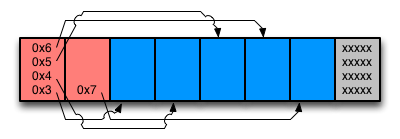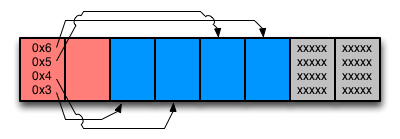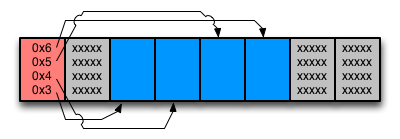Memory Page Stack
26 Jun 2012
Memory management
One of the most important tasks that the operating system has it to distribute the resources of the computer. One of those are the memory.
I like to divide the memory management of the kernel into three main parts:
- Physical memory management - Keeps track of the pages of actual memory
- Virtual memory management - Keeps track of the virtual address spaces
- Heap management - Fine grained control of memory for kernel use only
This post is about a part of the physical memory manager. This simple version keeps track of free pages of physical memory. When asked for a page, it hands it out and forgets about it until it is handed back.
Memory page stack
Pointers to the unused memory pages are stored on a stack and just popped off when needed.
The stack does of course take up an amount of memory, but through an interesting trick, this doesn't matter. You see, the memory where the stack is stored is made up of memory pages and if enough pages are handed out to clear an entire page in the stack, that page is next to be handed out.
Allow me to illustrate: Imagine a computer with really really small memory pages - so small in fact that each page only has room for four pointers. The figure below shows eight physical pages of a such computer. The two leftmost pages are used by the physical memory manager for the free page stack. The stack contains pointers to the next five pages, who are free. The rightmost page is handed out.

When the pmm receives a request for a memory page it will pop the topmost entry from the stack and returns, in this case, the second rightmost page to the caller.

The next time the pmm receives a request for a memory page it will notice that an entire page of the stack is empty and just being wasted, so it will shrink its stack by one page-size and return the address of the page that previously made up the top of the stack

Likewise, if the stack is full of pointers when a used page is handed back, that page is used to increase the stack space. Through the use of virtual memory and paging, the stack doesn't have to be contiguous in physical memory, so any page can make up a part of the stack.
Filling the stack
When the computer is booted up, the bootloader is asked to give the kernel a map of the available memory. This is used to initialize the stack. The kernel simply goes through the memory map returns each unused page it finds to the pmm.
Improvements
There's a lot more that can be done by the pmm. One major feature that will be added at a later state is keeping track of how many users each page has. This is useful if we wish to introduce shared memory or copy-on-write during forks. Otherwise we risk that a page is returned and handed out again while someone still think they have exclusive access to it. Not a good thing.
Git
This page stack has been implemented in Git commit caed8cb8a0. Also implemented in the same commit is a virtual memory manager with recursive page directories described in this post.
Note: There's a bug in that commit. In short, when filling the stack, the pmm looks for memory map entries between assert_higher(mmap_start) and mmap_start + mmap_size. Where the assert_higher macro pretty much just adds 0xC0000000 to the adress. Well... I'm sure you see what the problem is.
The bug has been rectified in Git commit ebaae73.